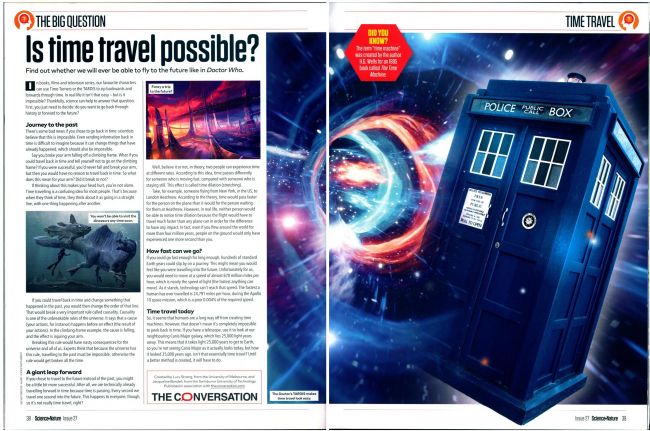Is time travel possible?
- Publication: Science + Nature
- Date: Oct. 2020
- Author: Lucy Strang, Jacqueline Bondell
- Page: 38
- Language: English
Find out whether we will ever be able to fly to the future like in Doctor Who.
In books, films and television series, our favourite characters can use Time-Turners or the TARDIS to zip backwards and forwards through time. In real life it isn't that easy — but is it impossible? Thankfully, science can help to answer that question. First, you just need to decide: do you want to go back through history or forward to the future?
Journey to the past
There's some bad news if you chose to go back in time: scientists believe that this is impossible. Even sending information back in time is difficult to imagine because it can change things that have already happened, which should also be impossible.
Say you broke your arm falling off a climbing frame. What if you could travel back in time and tell yourself not to go on the climbing frame? If you were successful, you'd never fall and break your arm, but then you would have no reason to travel back in time. So what does this mean for your arm? Did it break or not?
If thinking about this makes your head hurt, you're not alone. Time travelling is a confusing idea for most people. That's because when they think of time, they think about it as going in a straight line, with one thing happening after another.
If you could travel back in time and change something that happened in the past, you would then change the order of that line. That would break a very important rule called causality. Causality is one of the unbreakable rules of the universe. It says that a cause (your actions, for instance) happens before an effect (the result of your actions). In the climbing-frame example, the cause is falling, and the effect is injuring your arm.
Breaking this rule would have nasty consequences for the universe and all of us. Experts think that because the universe has this rule, travelling to the past must be impossible, otherwise the rule would get broken all the time.
A giant leap forward
If you chose to travel to the future instead of the past, you might be a little bit more successful. After all, we are technically already travelling forward in time because time is passing. Every second we travel one second into the future. This happens to everyone, though, so it's not really time travel, right?
You won't be able to visit the dinosaurs any time soon.
Well, believe it or not, in theory, two people can experience time at different rates. According to this idea, time passes differently for someone who is moving fast, compared with someone who is staying still. This effect is called time dilation (stretching).
Take, for example, someone flying from New York, in the US, to London Heathrow. According to the theory, time would pass faster for the person on the plane than it would for the person waiting for them at Heathrow. However, in real life, neither person would be able to notice time dilation because the flight would have to travel much faster than any plane can in order for the difference to have any impact. In fact, even if you flew around the world for more than four million years, people on the ground would only have experienced one more second than you.
How fast can we go?
If you could go fast enough for long enough, hundreds of standard Earth years could slip by on a journey. This might mean you would feel like you were travelling into the future. Unfortunately for us, you would need to move at a speed of almost 670 million miles per hour, which is nearly the speed of light (the fastest anything can move). As it stands, technology can't reach that speed. The fastest a human has ever travelled is 24,791 miles per hour, during the Apollo 10 space mission, which is a poor 0.004% of the required speed.
Time travel today
So, it seems that humans are a long way off from creating time machines. However, that doesn't mean it's completely impossible to peek back in time. If you have a telescope, use it to look at our neighbouring Canis Major galaxy, which lies 25,000 light years away. This means that it takes light 25,000 years to get to Earth, so you're not seeing Canis Major as it actually looks today, but how it looked 25,000 years ago. Isn't that essentially time travel? Until a better method is created, it will have to do.
Created by Lucy Strang, from the University of Melbourne, and Jacqueline Bondell, from the Swinburne University of Technology.
Published in association with theconversation.com
The Doctor's TARDIS makes time travel look easy.
Disclaimer: These citations are created on-the-fly using primitive parsing techniques. You should double-check all citations. Send feedback to whovian@cuttingsarchive.org
- APA 6th ed.: Bondell, Lucy Strang, Jacqueline (Oct. 2020). Is time travel possible?. Science + Nature p. 38.
- MLA 7th ed.: Bondell, Lucy Strang, Jacqueline. "Is time travel possible?." Science + Nature [add city] Oct. 2020, 38. Print.
- Chicago 15th ed.: Bondell, Lucy Strang, Jacqueline. "Is time travel possible?." Science + Nature, edition, sec., Oct. 2020
- Turabian: Bondell, Lucy Strang, Jacqueline. "Is time travel possible?." Science + Nature, Oct. 2020, section, 38 edition.
- Wikipedia (this article): <ref>{{cite news| title=Is time travel possible? | url=http://cuttingsarchive.org/index.php/Is_time_travel_possible%3F | work=Science + Nature | pages=38 | date=Oct. 2020 | via=Doctor Who Cuttings Archive | accessdate=20 May 2025 }}</ref>
- Wikipedia (this page): <ref>{{cite web | title=Is time travel possible? | url=http://cuttingsarchive.org/index.php/Is_time_travel_possible%3F | work=Doctor Who Cuttings Archive | accessdate=20 May 2025}}</ref>
